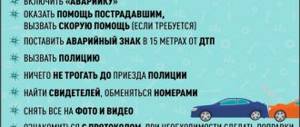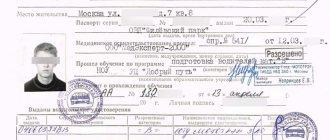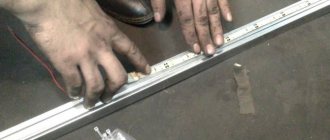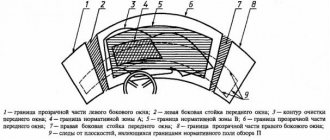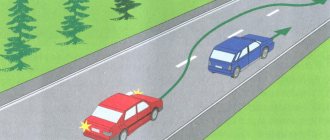Home \ Articles \ What is a tachograph and who needs it?
Drivers, especially those driving trucks and passenger buses, are well aware of what a tachograph is. These control devices have been used for a long time and are installed on equipment to monitor mileage, speed, travel time and other indicators.
Requirements for equipping cars with tachographs are becoming more stringent over time. This is due to the fact that traffic control using on-board recorders can reduce accident rates, ensuring safer driving.
What is a tachograph?
A tachograph is a device that is installed in a car and connected to its on-board network and engineering systems. The main function of the device is to automatically register vehicle movement parameters and store this data in memory with the ability to view it during testing.
Modern devices:
- The vehicle's mileage and driving speed are recorded.
- The time of driving, rest and other work performed by the driver is recorded.
- All data is registered, encrypted and stored in a form protected from editing.
The last point is especially important. The information recorded by the flight recorder is as objective as possible and cannot be changed. Therefore, it has evidentiary value and can be used in resolving controversial issues, including in court.
How does a tachograph work?
Digital tachographs consist of a vehicle unit, a motion sensor and maps. The car unit is the motherboard and the “brains” of the tachograph, with a processor, clock, two memory card slots, a display, a printer, a download connector and a controller for manual data entry. The unit itself is located in the driver's cabin. The motion or speed sensor is installed on the gearbox.
What does a digital tachograph record?
- Vehicle registration date;
- vehicle speed;
- number of drivers;
- how many times the driver card is inserted each day;
- the distance traveled by the driver, measured by the odometer;
- driving activities (driving, rest, breaks, other activities);
- date and time of activity change;
- events (speeding, driving without a driver card, interference, attempted fraud) and errors;
- execution verification;
- tachograph calibration details.
The principle of operation of a tachograph is that it monitors the status of all vehicle systems in real time and records errors and violations, as well as malfunctions in the operation of the vehicle. This is a kind of electronic on-board computer that works without the driver’s participation and records all his actions, regardless of his wishes. Read a more detailed article about the operation of the tachograph here.
.DDD files
The data is stored as a .ddd file, which can be imported into a tachograph analysis program. Special software decrypts the information and displays it in text format.
The data is sent via the control unit directly to the platform. All files are checked for completeness and integrity, so you always know whether your archive complies with legal requirements.
Regardless of the type of storage of files and their format, they cannot be edited, since the file will be damaged and will not open in the program. The data is for viewing and reference purposes only. If the driver and/or a third party is caught attempting to falsify data, this may lead to negative consequences, including an administrative fine.
The design of the tachograph and the principle of its operation
The design of the flight recorder is quite simple. The main unit is located in the vehicle cabin so that the driver has access to the front panel with control buttons. Modern tachographs are equipped with screens that display basic information about the operation of the system.
The control system is connected to the machine's on-board network to provide power. Autonomous operation when the engine is turned off is guaranteed by the large battery capacity. In addition, a non-volatile memory module is built into the device, so the data recorded by the tachograph is saved in any case.
To transmit information about the movement of the vehicle, a speed sensor is connected to the device. The connection is made using standard connectors.
An important function of modern tachographs is access personalization. To use the device, you must install a personal driver card: only in this case will the information be correctly recorded and stored in memory. In addition to the driver’s tach card, cards of workshops, companies and controllers are used when working with devices.
How does a tachograph work?
Analog tachograph.
The tachograph is a small-sized device; its installation does not require much space. The tachograph includes several main components:
- A card reader designed to identify vehicle crew members.
- Device for encryption with GLONASS.
- Display and control buttons.
- A special motion controller that has a data encryption function.
- GPRS device that transfers information to the server.
- A printing block that makes it possible to print data on paper.
After installation, the tachograph is connected to the vehicle's electrical network using any of the standard methods.
Types of tachographs
Initially, cars were equipped with analog (disk, mechanical or electronic-mechanical) devices. Today, the use of analog recorders is not permitted by law. In addition, such tachographs are no longer produced, so it will be difficult to find a working model.
An alternative is digital recorders, which immediately collect and process information in digital form. In the Russian Federation, tachographs of the following brands are most often installed:
- CASBI
- SHTRIH-TahoRUS
- VDO DTCO
- Mercury
- ATOL et al.
It is also possible to install on machines some foreign-made devices that have been certified and approved for operation in Russia.
Should a tachograph be installed on a dump truck?
For dump trucks working in construction companies, the installation of a tachograph is clearly required. Is monitoring equipment installed on dump trucks used by public utilities? The traffic police in most regions requires the installation of tachographs on this type of transport. The equipment is not installed only on special vehicles equipped with brushes for cleaning roads and similar devices. The same applies to dump trucks used in the gas and oil fields.
What to do if you have your own truck?
Owners of private vehicles to install tachographs . They are installed only on cars registered to legal entities and individual entrepreneurs. Some companies take advantage of this and offer drivers to register cars in their name, mercilessly exploiting their labor, risking not only the transport unit, but also the life of their employee.
CIPF modules (NKM), their purpose
Depending on the flights the vehicle operates, the requirements for the brand and design of the flight recorder may vary:
- For cars that operate international flights, the use of AETR tachographs will be mandatory.
- Vehicles operating in the Russian Federation are equipped with tachographs with a CIPF/NKM module (navigation cryptographic protection module).
The CIPF unit is a cryptographic data protection system that is built into the flight recorder. This unit is highly autonomous and includes its own memory module, GLONASS receiver, chronometer and accelerometer. Power is also provided from a backup battery, so cryptographic protection works even when the flight recorder is de-energized.
The main function of CIPF is to collect information, encrypt it and store it. Data from the speed sensor enters the CIPF module, is processed by the microprocessor and stored in its memory in encrypted form. Changing this data is impossible, and for access with decryption you need to use a special electronic key.
The lifespan of the NCM module is limited. The element installed in the tachograph is activated when you start using the device. After this, once every 3 years it is necessary to replace the CIPF unit and activate the new module. Only workshops with a license from the FSB of the Russian Federation to work with cryptographic equipment can provide the service for replacing and activating NCM.
Which tachograph to install
There are three types of tachographs. It is very important to separate the types of tachographs, if only because the cards are suitable for different types. The tachograph will not accept a driver card made for a different type of tachograph.
- Russian, with a cryptographic protection unit (CIPF). Drivers call them tachographs “with a PIN code”, since they are the only ones that require entering a PIN code after inserting the driver card. Current domestic tachographs used for domestic Russian transportation. Regulated by Order of the Ministry of Transport 440 (link to it at the beginning of the article) and GOST 34005-2016
- Russian ones without a cryptographic information protection block. Prior to the introduction of the legal requirement for the block in 2013, a large number of tachographs were produced without these blocks. Most of them were retrofitted with blocks if the technical feasibility and design of the device allowed.
- European (ETR). Used in Europe. May already be installed on European trucks or buses. Travel to Europe is only possible with an AETR tachograph. The initial installation of an AETR tachograph on a car is more expensive and more difficult than installing a domestic one, due to more serious requirements for speed sources. The AETR requires two speed sensors, and the main one must be with cryptographic protection.
CIPF unit (NKM) for tachograph
In Russia, uncorrected data storage is ensured by the use of a special cryptography-protected (and therefore subject to legal regulation) block. CIPF stands for “Cryptographic Information Protection Tool”. There is another abbreviation that may appear on the printout - NCM (“Navigation Cryptographic Module”), since the unit has a built-in GLONASS module and remembers its location.
The unit is activated by the tachograph workshop and works for three years. The service life is limited by software, which means that after three years the tachograph will issue a warning and then stop accepting the driver card.
Controversy over the legality of various tachographs
Stories about the “illegal demands” of CIPF tachographs are periodically inflated on the Internet. If you study the issue more seriously, then, as a rule, in the depths of history there is always some commercial company promoting its commercial interests. For example, access to cheap stocks of used European tachographs, or legal services provided. If you look for a little more information, it turns out, for example, that the “cancelled fine for a tachograph” was canceled not because CIPF cannot be legally required, but because the inspector made mistakes when drawing up the protocol. The carrier himself decides what is more important for him, to work, or to spend time and money on courts with the traffic police.
“On the Internet, someone is always wrong.” And there are also many who just want to sell you something. Read the laws yourself.
We leave it to the carrier to decide which tachograph to install. As a workshop authorized to work on all types of tachographs, it does not matter to us which tachograph the client installs. But it is worth remembering that AETR tachographs installed specifically according to AETR requirements are more expensive to install, and cannot be repaired if they break down; the workshop does not have the right to open them.
Domestic tachography is quite young, but nevertheless there are no prerequisites for the abolition of CIPF and are not expected. To do this, it is not enough to change only order 440; the essence of these requirements is contained in the very nature of the tachograph. It must store information in an encrypted and tamper-proof form, and this automatically means regulation related to cryptography.
The official list of tachograph models approved for installation is on the website of the Federal Budgetary Institution “Rosavtotrans”.
On what vehicles is a tachograph installed?
The universal design of on-board recorders allows them to be installed on almost any car and other vehicles. But for some categories of transport, equipping with a control device will be mandatory by law.
The main criterion that determines whether a tachograph needs to be installed is the purpose of using the vehicle. If a car or bus is used for personal purposes, then it is not necessary to install the device (but you can - this way you will get additional information about the lust mode). But if the technology is used by a commercial organization, then it is impossible to do without a control device.
Note! If the vehicle is periodically operated in conditions that do not provide for the use of a tachograph, then it is advisable to install a recorder that supports the “OUT” mode. But this mode can only be activated when the car is not on a commercial flight - for example, it is being transported within the territory of an enterprise or to a workshop for maintenance. Using the “OUT” mode during freight or passenger transportation is a violation!
According to the laws, tachographs must be placed on:
- Trucks whose total weight exceeds 3.5 tons (categories N2, N3)
- Buses and minibuses, the design of which provides for the presence of 8 or more passenger seats, belonging to categories M2, M3 (this also applies to equipment used for transporting people on suburban and intracity routes).
- Trucks that transport cargo of various hazard classes.
- Dump trucks.
- Loader cranes.
The list of exceptions includes military equipment, equipment belonging to law enforcement agencies, construction and municipal special equipment, trolleybuses and some other vehicles,
And one more example: is a tachograph needed for a personal minibus?
We answer a number of questions to get an answer:
- Who operates a personal minibus? Let's say an individual.
- What type of personal minibus is it? A minibus is a passenger vehicle, up to 5 tons. We look at the documents for the permitted maximum weight. ZIL 5301 is 6,950, which means a car of type N2.
- What is the environmental class of the car? We look at STP or PTS. If the environmental class has not been established, then the minibus must be equipped with a tachograph before December 1, 2021. If the EC is from 0...3, then the tachograph must be installed no later than March 1, 2021. If EC 4 and higher, then until June 1, 2021.
Checking the device by regulatory authorities
Having understood what a tachograph is and what vehicles it needs to be installed on, it is worth understanding the features of carrying out control measures.
Since for many categories of vehicles the presence of tachographs, as well as compliance with the requirements for their operation and operating modes, is mandatory, control is carried out on the routes. The check can only be carried out by traffic police officers and inspectors from Rostransnadzor. Moreover, if previously only joint checks were carried out (at weight and dimensional control points), today representatives of Rostransnadzor can check cars independently.
During the inspection, a representative of the regulatory authority is obliged to make sure that a working device is installed on the machine, the design of which complies with current standards. The integrity of the seals and the absence of traces of interference with the operation of the device are also checked.
Using the controller card, the following are checked:
- Time intervals for driving and rest.
- Compliance with the requirements for the use of individual tach cards.
- Compliance with device verification deadlines.
What is CIPF in a tachograph?
CIPF (cryptographic information protection tools) is a standard developed by Russian specialists. Tachographs of the third group equipped with such blocks cannot be exported outside the Russian Federation; they are used only within the country.
Despite the fact that devices with CIPF are slightly more expensive than those with AETR, their installation and use have several significant advantages. In particular, the Russian standard, unlike the pan-European one, does not require the mandatory installation of a speed controller. And this reduces the cost of installing the device by at least 6-7 thousand rubles. Speed calculations in devices with CIPF are performed through the GLONASS system.
Tachograph installation
You will not be able to install the device in a car yourself; to do this, you must contact a service center that has the necessary permits. Such organizations are registered with the Federal Budgetary Institution "Rosavtotrans" and receive licenses to work with cryptographic equipment.
When preparing a car for installation, technicians select a place to install the device in such a way that the driver can carry out manipulations without being distracted from driving the car. To do this, you may need to install special brackets or lay cables to connect the system.
Next, the new device is unpacked and connected to the on-board network and speed sensor. All connections are carefully insulated.
The device itself and the cryptographic module are activated. Once activated, the device is calibrated to ensure the accuracy of the data collected.
The final stage of installation is sealing the device body. Installing seals is necessary in order to protect the system from tampering, attempts to edit data, or deliberate damage. The tachograph in a sealed case is installed in the socket and fixed.
Types of tachographs
There are two main versions of the case - round (looks like a speedometer) and rectangular (looks like a car radio). According to the method of recording information, tachographs are of two types:
- Analogue devices, which were in wide use earlier, are now prohibited for installation at the legislative level and are almost completely out of use. They record the data on the tachodisk, and the data about the driver was filled out initially. The main disadvantage: they are quite easy to deceive.
- Digital devices with a crypto module record information on an electronic card and are also capable of supporting a global positioning system. It is almost impossible to deceive them.
Digital tachograph.
According to legal subordination, digital tachographs are divided into three main groups:
- AETR (analog and digital),
- without means of cryptographic information protection (order 720),
- with a navigation and cryptographic module (cryptographic module) block.
The AETR is a European agreement that brings order to the regulation of the work of drivers of vehicles engaged in international road transport. European standard tachographs are based on European legal regulations based on ISO provisions. Russia has signed and ratified an international treaty on the use of such tachographs. It applies to any vehicles registered in countries participating in the AETR, or moving on the roads of countries participating in the agreement.
Calibration steps
Correct operation of the device (i.e. recording the most objective indicators of time, speed and mileage) is ensured by its periodic calibration. During this operation, the device is adjusted in such a way that the recorded data corresponds to the objective data with a minimum error.
The first time the system is calibrated during installation, then adjustment may be necessary during repairs, changing the technical characteristics of the vehicle, replacing wheels with a change in diameter, or installing a new speed sensor. It is also necessary to calibrate if the housing seal is broken and after a two-year period has passed since the last adjustment.
The tachograph is calibrated first on a stand and then on the road. At the first, bench stage:
- The integrity of the case, individual elements, and the safety of seals are monitored.
- The correct operation of the sensors is checked.
- Electrical circuits are tested.
The second stage - road tests - includes:
- Vehicle inspection.
- System programming.
- Control and adjustment of recording time, speed, distance traveled.
- Measurement of error.
After calibration is completed, all necessary information is entered into memory, and the case is sealed. A calibration mark with a fixed date is entered in the documentation for the device.
Tachograph calibration
To avoid legal disputes and doubts about the correctness of the tachograph records, a certified specialist calibrates it, after which he makes the necessary adjustments and certifies the quality of the work with his own signature and seal. The video below clearly shows how to calibrate.
Calibration includes recording the most accurate time, checking the operation of the sensors, setting the necessary parameters, testing and sealing the device. There is a certain procedure for calibrating a tachograph.
- Preliminary inspection: the integrity of the case, seals, and the absence of visible damage (any) are checked.
- The operation of all electrical circuits and tachograph sensors is checked at the stand.
- A specialist inspects the vehicle and ensures that the tachograph is installed correctly.
- With access from the service card, initial programming of the device is performed.
- Road testing involves ensuring that the vehicle's time, speed, distance traveled and route are correctly recorded. Errors are measured and entered into the device’s memory.
- The specialist seals the body and gives the vehicle owner documents about the work performed.
Tachograph card and its purpose
Access to the system functionality and data stored in memory is impossible without using an electronic key card. Tachocards are equipped with special chips and have a limited lifespan, so they must be reissued periodically.
The most common type of card is the driver card. It is personalized, i.e. issued in the name of the person who will drive the vehicle with the flight recorder. The main task of the card is to identify the person who drove the car during a certain period of time.
Note! Using the device without a card or with someone else's electronic key is not allowed, and if such a fact is discovered, penalties are guaranteed to follow. The same applies to attempting to operate a tachograph with an expired driver card, so you should think about replacing the chip in advance.
In addition to this variety, the following are also used:
- Workshop maps - for installation, configuration and calibration.
- Enterprise cards - for accessing data stored in the device’s memory, decrypting and analyzing it (but not editing information).
- Controller cards – for accessing information stored in memory during control activities.
Tachograph operating rules
Before driving, the person driving the vehicle must insert a personal card into the appropriate receiver. In this way, control is exercised over all actions of the person driving the vehicle along the route.
The driver card is valid for 3 years; after the specified period, it must be reissued again.
Each person driving a vehicle equipped with a tachograph is required to undergo training in labor discipline, operating mode and knowledge of the operating instructions.
The driver's action algorithm is simple:
- At the beginning of the shift, you must insert your personal card into the receiver slot with the chip facing up.
- After reading the information, the driver information will be displayed on the display.
- If the device fails to accept the card, you should immediately report the problem to your immediate supervisor and submit the card for diagnosis and repair, if such a need arises, at a specialized service center.
- After the start of movement, the tachograph begins to record the read information regarding speed, travel time, location and other data related to the driving mode. "
- After stopping and turning off the ignition, the tachograph automatically goes into standby mode.
- At the end of the shift, the driver is required to remove his card by pressing the appropriate key on the device, after which the device will record the end of work.
It is prohibited to drive a vehicle without an active personal card, and it is also prohibited to use someone else’s card.
How to use a tachograph?
The design of flight recorders is simple, so learning to work with them is not difficult. But any driver must remember the basic algorithm, because its violation will definitely be recorded by the device. This may lead to sanctions - both in relation to the driver himself and in relation to company representatives.
| Number of drivers in the crew | |||
| 1 driver | 2 or more | ||
| Norm | Allowed | ||
| Max. continuous control time | 4.5 hours | 4.5 hours | |
| Min. break time | 45 minutes | divided into intervals no shorter than 15 minutes | 45 minutes |
| Max. management time per day | 9 o'clock | 10 hours x 2 days a week | >9 hours |
| Max. management time per week | 56 hours | 90 hours in any 2 weeks | 56 hours |
| Min. daily rest time | 11 o'clock | 9 hours 3 days a week, 12 hours in 2 intervals, one of which is not shorter than 9 hours | During 30 hours of work, each driver must have a rest of at least 9 hours continuously |
| Min. weekly rest time | 45 hours | at least 24 hours | 45 hours |
Before starting to drive the car, the driver must install an individual card in a free slot and activate it by entering a PIN code. After this, the driver’s name should appear on the screen - this indicates that. who has accepted the card and you can start working:
- First, the driver selects an activity before the start of the shift - “Rest” or “Work” (if before driving he was already performing his duties - for example, accepting cargo).
- When you turn on the ignition, the “Driving” mode is activated automatically, and an icon in the form of a steering wheel appears on the screen. The mode is maintained even if the car is parked with the engine running.
- The “Rest” mode is activated differently in different device models: either automatically, when the engine is turned off, or by pressing the corresponding button.
The card is removed from the slot by pressing a special button after completing the work shift.
Modern models of recorders are equipped with built-in thermal printers for daily printing of data from the device’s memory. Printing is also carried out at the request of employees of regulatory authorities, therefore it is important. So that the printer is in good working order and there is always paper in it (the required supply in the cabin is at least 2 rolls).
Tachograph modes
The tachograph has 4 operating modes: driving, other activities, rest and availability. "Driving mode" is activated automatically when the car is in motion. A digital tachograph usually selects the "other operation" mode automatically after it is stopped. The "rest" and "availability" modes can be manually selected by the driver while stationary. The tachograph operating mode is displayed in symbolic form on the front panel.
Important!
Activity information is stored in the internal memory of the device and at the same time on the digital driver card chip while it is inserted into the tachograph head. When the memory is full, later data is automatically overwritten by new data. This is one of the reasons why companies are trying to use digital tachographs, which allow data to be stored for a sufficiently long period of time.
Fines for violations
The absence of a tachograph, its malfunction, or untimely verification/replacement of CIPF are considered violations from the point of view of the law. Violations also include operating the recorder without a driver card, with someone else’s or an expired card, or the inability to print data at the request of a traffic police officer.
Depending on who is found to be the culprit of the violation, Article 11.23 of the Code of Administrative Offenses establishes the following amounts of fines:
- up to 3 thousand rubles for individuals. Directly managing the vehicle.
- up to 10 thousand - for officials responsible for violations.
- up to 30 thousand - for legal entities.
| Uninstalled/non-functioning/non-compliant tachograph | ||
| Responsible person | Now | will become |
| Driver | from 1,000 to 3,000 rubles | from 3,000 to 5,000 rubles |
| Executive | from 5,000 to 10,000 rubles | from 7,000 to 10,000 rubles |
| Legal entity and individual entrepreneur | from 20,000 to 50,000 rubles or suspension of activities for up to 90 days | |
In the near future, it is planned to revise the amount of fines upward. It is also possible to impose additional sanctions, up to and including suspension of the company’s activities or revocation of its license.
| Failure to comply with the work and rest schedule of drivers | ||
| Responsible person | Now | will become |
| Driver | from 1,000 to 3,000 rubles | from 3,000 to 5,000 rubles |
| Executive | from 7,000 to 10,000 rubles | |
| Legal entity and individual entrepreneur | from 20,000 to 50,000 rubles or suspension of activities for up to 90 days | |
Knowing what a tachograph is, how it works, and how it should be used correctly, you can guarantee the absence of claims from the traffic police and other regulatory organizations. In addition, equipping equipment with recorders makes it possible to increase the efficiency and safety of transportation.
What it is
A tachograph is a special device for measuring and monitoring vehicle movement parameters. It is a small device that is responsible for recording and storing the most important indicators of car movement:
- speed;
- route;
- compliance with traffic rules;
- adherence to work and rest standards.
According to traffic rules, the driver must rest after 4 hours of continuous driving. Rest should last at least 40 minutes.
Initially, this device was used to preserve the life and health of drivers and reduce the number of accidents. Now the purposes for its use have expanded, and the devices themselves have become more functional. The following features have been added to the main functions:
- fixing the speed limit and determining the average speed;
- driver's work period;
- suppression of speeding and driver fatigue.
It is prohibited for vehicles to enter the territory of EU member states without tachographs that were registered after June 16, 2010. We found out why a tachograph is needed, and this should no longer be a problem. But with the tachograph CIPF unit, not everything is clear. Such a device became mandatory for all tachographs from February 13, 2013.
Such a mechanism is needed to encrypt and decrypt information that is recorded by the tachograph. The operation of CIPF is based on a digital signature, which is issued by a special certification center. Installing such a block makes it impossible to correct and delete information without first decrypting it.
CIPF has the form of a small block equipped with an input for a navigation antenna. This block can be inserted inside all digital tachographs approved for use in the Russian Federation. Any manipulations with this device are prohibited in the absence of a license issued by the FSB. When you know what a tachograph CIPF unit is, we can move on to studying the following issues.
What does a tachograph consist of and how does it work?
Although such devices are produced in a wide variety, their operating principle remains unchanged. Even their structure is similar in most cases:
- the speed sensor is responsible for recording the speed of the car and determining the distance left behind;
- the rechargeable battery provides accounting of the collected information;
- the on-board unit is responsible for monitoring the vehicle’s operating mode, optimal speed and driver rest;
- display with control buttons;
- encryption device;
- a card reader, which is used to identify each driver;
- device for displaying information on paper;
- GPRS module for transmitting data to the server.
Connecting the device can be done using CAN buses and other less complicated methods. How the tachograph works and what elements it consists of has already become more clear, so we can move on. We have to look at the existing varieties of this equipment, which has recently become mandatory for some drivers.
Types of tachographs
These devices are available in several varieties. The classification is based on different parameters.
- Round models are connected to the speedometer socket.
- Radio format devices are mounted in a socket intended for a car radio.
- Digital models are modern, reliable and tamper-proof. Information is recorded in the built-in memory and is difficult to access, delete or change. Any attempts to gain access to information will be recorded and the driver will have to bear responsibility for such actions.
- Analog ones have an electronic-mechanical basis. They are the very first copies, which have now become obsolete and even banned. Such devices can be easily hacked, so their information cannot be considered reliable.
Which tachographs are allowed for installation in Russia
You cannot install any tachograph you like on your car. This device must meet the requirements specified in Orders of the Ministry of Transport No. 36 and No. 348. Two types of devices are approved for installation on Russian cars:
- Models produced by domestic manufacturers, equipped with a CIPF unit. This includes copies of SHTRIH-TahoRUS SM and VDO DTCO 3283, model KASBI DT-20M and TCA-02NK, Mercury products TA-001 and EFAS V2 RUS, as well as Drive 5 and Drive Smart tachographs.
- Devices from European manufacturers approved for use in Russia are represented by the English VDO DTCO 1381 and SE5000, and the Austrian EFAS 4.
Which printouts correspond to the type of violation:
Driving without a map
- From the tachograph memory: printout per day
- Designation in the printout:
Expired NCM
- From the tachograph memory: information about the CIPF block (NKM module)
- Only for tachoraphs with a cryptographic information protection unit. Not used in AETR.
- Designation in the printout:
Overnight cards in the tachograph
- From the tachograph memory: printout per day
- The end time of the last activity must coincide with the end of the shift.
- Designation in the printout:
Malfunction from tachograph memory
- From the tachograph memory: printout per day
- The last 5 events and faults from the tachograph memory.
- Designation in the printout:

